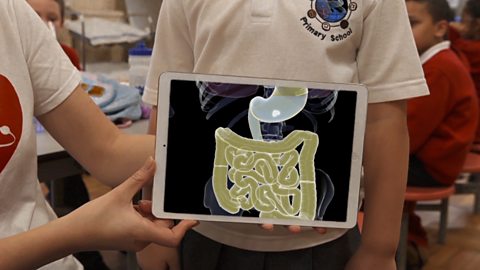JAMIE:'Mum! My trousers have split again!'
PRESENTER:Jamie is 10 years old, and Ella is 7. Their bodies have changed a lot since they were born.
PRESENTER:'Our bodies are changing all the time.
PRESENTER:Before we are born, our bodies develop from a single cell into a baby, in just nine months.
PRESENTER:'To start the development of a human being, a male sperm fertilises a female egg. This fertilised egg contains all the information it needs to grow into a person.
PRESENTER:'This cell divides and divides, turning into organs and bones, and eventually will become a baby.
PRESENTER:'After about ten weeks, the baby's heart is beating. At about 20 weeks, you can feel the baby start to move. After nine months of development, the baby is fully formed and ready to be born. If this rate of growth continued throughout childhood, then Jamie, at 10 years old, would be over nine feet tall, and weigh over 45 stone.'
PRESENTER:Have you ever wondered how something like solid bone grows?
PRESENTER:Our skeletons are made up of bones and a strong flexible substance called cartilage.
PRESENTER:'Long bones, such as your thigh bone, or femur, grow in length at either end, in regions called growth plates. Growth happens when cartilage cells increase in number in these growth plates. New cartilage cells push older, larger cartilage cells towards the middle of a bone. When we're about 25 years old, most of our bones have finished growing. When long bone growth stops, you stop getting taller.'
PRESENTER:So Ella will grow to be as tall as Jamie.
PRESENTER:But when Jamie's about 14, he will experience a growth spurt as well.
PRESENTER:'How tall will they be when they are fully grown? Well, hopefully not this tall!'
PRESENTER:If you want to know how tall you're likely to be when you're grown up, look at Mum and Dad.
PRESENTER:'Do people say, "Oh, you've got your mother's eyes", or '"You're tall, just like your dad!" That's because you inherit one set of genes from your mum, and one set of genes from your dad. Your genes contain all the information needed to make you. Right down to the colour of your hair, your ability to roll your tongue, or even wink.
PRESENTER:'All the children have been asking their relatives about what features they think they have inherited from their family. Everyone has made a list, and is now doing a drawing of what they think they might look like when they grow up.
PRESENTER:Once we become adults and we stop getting taller, our bodies are still changing all the time. The skin you see now will be gone in about a month, replaced by newer skin cells. We can become ill, and our bodies work hard to make us better. We could break bones, and heal them. Build up muscles, grow long hair, or even lose it all!
PRESENTER:'We could become fat or thin.'
PRESENTER:'Need glasses or have children. Our bodies change constantly. When we get older, our hair turns grey and our skin wrinkles.
PRESENTER:'We don't move as easily and comfortably as we once did, but nothing makes us happier, than seeing the cycle of life begin again.'
Video summary
Zoe talks us through the process of human life, using graphics to show how we grow inside the womb.
Brother and sister Jamie and Ella are used to show how children grow, and we hear how bones grow longer until we are aged about 25, by cartilage cells in growth plates increasing in number.
Zoe explains further changes to the human body throughout our lives, caused by injury, illness, changes in weight, childbirth and ageing.
We hear how Jamie and Ella's parents have given them each half of their genes, which means they inherit features from them.
The class draw pictures to represent the features they have inherited from their parents.
This short film is from the BBC series, Biological processes of the human body.
Teacher Notes
Pupils could create a drawing of themselves and describe their eye colour, skin colour, etc.
Ask them to draw a picture of their mother or father and describe the features they have inherited.
They could look at famous people such as the Spanish royal family in Velazquez’s 18th century paintings as an extreme example.
Pupils could make a collage of famous families and see what they have inherited through the generations.
This short film will be relevant for teaching the topic of the human body at KS2 in England, Wales and Northern Ireland and Second Level in Scotland.
Digestion - how does breakfast affect your day? video
The impact of having a healthy breakfast is explored, and a rather disgusting experiment highlights how the body gets nutrients out of food.
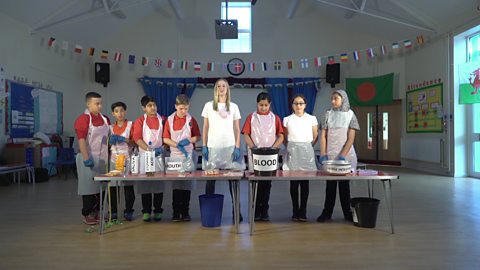
How do muscles and bones work? video
A model skeleton, elastic bands and rubber gloves are used to demonstrate how our muscles and bones allow our bodies to move.
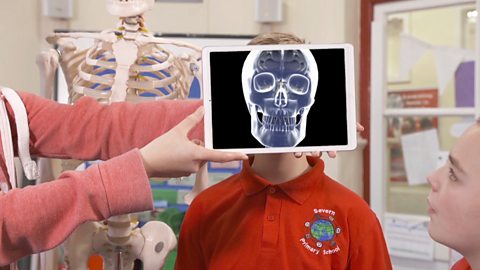
Respiration - how is oxygen transported round the body? video
Exploring how oxygen is transported around our bodies using an experiment to test lung capacity.
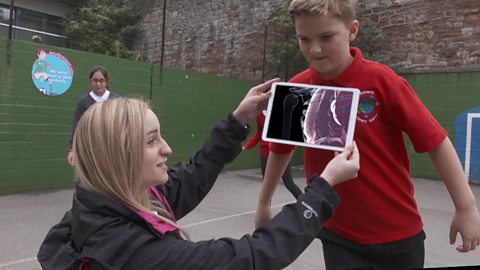
Teeth - how they help animals eat. video
How different types of animals use their teeth to help them eat their food.

How our circulatory system keeps us alive. video
Zoe uses CGI graphics to explain the structure of the heart and the difference between veins and arteries.
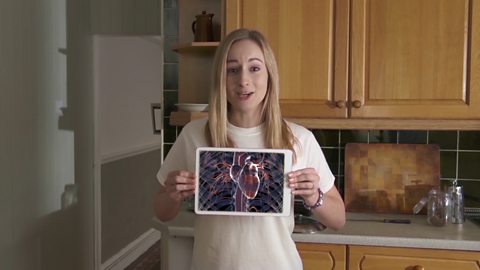
What causes us to burp and break wind? video
A light-hearted look at the biological processes that make us burp and fart.
